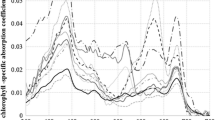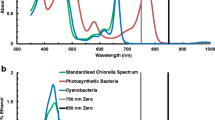Abstract
To assess, respectively, the contribution of red bacteria of theHalobacterium-Haloferax-Haloarcula group and of the β-carotene-rich green algaDunaliella salina to the red colour of saltern crystallizer ponds, we studied the optical properties of the brines of NaCl-saturated saltern ponds in Eilat, Israel, and quantified the pigments present in their biota. The absorption spectrum of the brines, as measured using the opal glass method to reduce the interference by scattering, or using an integrating sphere, nearly corresponded to thein vivo absorption spectrum of bacterioruberin-containing red archaeobacteria. However, extracts of the microbial community in organic solvents were dominated by β-carotene, a pigment occurring in high concentrations in theDunaliella cells present, and bacterioruberin contributed only between 13 and 28 per cent of the total visible light absorption by the extracts. The apparent discrepancy between these results can be explained by the very small in vivo optical cross-section of β-carotene, which is densely packed in globules inside theD. salina cells.
Similar content being viewed by others
References
Aasen, A.J., Eimhjellen, K.E. and Liaaen-Jensen, S. 1969. An extreme source of β-carotene.Acta Chemica Scandinavica 23: 2544–2545.
Baas-Becking, L.G.M., 1931. Historical notes on salt and salt-manufacture.Scientific Monthly 32: 434–446.
Ben-Amotz, A. and Avron, M., 1983. On the factors which determine massive β-carotene accumulation in the halotolerant algaDunaliella bardawil.Plant Physiology 72: 593–597.
Ben-Amotz, A. and Avron, M., 1989. The biotechnology of mass culturingDunaliella for products of commercial interest. In: R.C. Cresswell, T.A.V. Rees and N. Shah (Eds)Algal and Cyanobacterial Biotechnology. pp. 91–114. Longman Scientific and Technical Press, Harlow, U.K.
Ben-Amotz, A., Shaish, A. and Avron, M., 1989. Mode of action of the massively accumulated β-carotene ofDunaliella bardawil in protecting the alga against damage by excess irradiation.Plant Physiology 91: 1040–1043.
Borowitzka, L.J., 1981. The microflora. Adaptation to life in extremely saline lakes.Hydrobiologia 81: 33–46.
Davis, J.S., 1974. Importance of microorganisms in solar salt production. In: A.H. Coogan (Ed.)Fourth Symposium on Salt. Vol. 2. pp. 369–372. Northern Ohio Geological Society, Cleveland.
Dubinsky, Z., 1992. The functional and optical absorption cross-sections of phytoplankton photosynthesis. In: P.G. Falkowski and A.D. Woodhead (Eds)Primary Productivity and Biogeochemical Cycles in the Sea. pp. 31–45. Plenum Press, New York.
Dundas, I.E.D., 1977. Physiology of the Halobacteriaceae. In: A.H. Rose and D.W. Tempest (Eds)Advances in Microbial Physiology. Vol. 15. pp. 85–120. Academic Press, London.
Dundas, I.D. and Larsen, H., 1962. The physiological role of the carotenoid pigments ofHalobacterium salinarium.Archiv für Mikrobiologie 44: 233–239.
Gochnauer, M.B., Kushwaha, S.C., Kates, M. and Kushner, D.J., 1972. Nutritional control of pigment and isoprenoid compound formation in extremely halophilic bacteria.Archiv für Mikrobiologie 84: 339–349.
Imhoff, J.F., Sahl, H.G., Soliman, G.S.H. and Trüper, H.G., 1979. The Wadi Natrun: chemical and microbial mass developments in alkaline brines of eutrophic desert lakes.Geomicrobiology Journal 1: 219–234.
Jannasch, H.W., 1957. Die bakterielle Rotfärbung der Salzseen des Wadi Natrun (Ägypten).Archiv für Hydrobiologie 53: 425–433.
Javor, B.J., 1983a. Planktonic standing crop and nutrients in a saltern ecosystem.Limnology and Oceanography 28: 153–159.
Javor, B.J., 1983b. Nutrients and ecology of the Western Salt and Exportadora de Sal saltern brines. In: B.C. Schreiber and H.L. Harner (Eds)Proceedings of the Sixth International Symposium on Salt. Vol 1. pp. 195–205. The Salt Institute, Toronto.
Javor, B., 1989.Hypersaline Environments. Microbiology and Biogeochemistry. Springer-Verlag, Berlin.
Kushwaha, S.C. and Kates, M., 1979. Effect of glycerol on carotenogenesis in the extreme halophile,Halobacterium cutirubrum.Canadian Journal of Microbiology 25: 1288–1291.
Larsen, H. 1980. Ecology of hypersaline environments. In: A. Nissenbaum (Ed.)Hypersaline Brines and Evaporitic Environments. pp. 23–29. Elsevier, Amsterdam.
Lers, A., Biener, Y. and Zamir, A., 1989. Photoinduction of massive β-carotene accumulation by the algaDunaliella bardawil.Plant Physiology 93: 389–395.
Nelis, H.J. and De Leenheer, A.P., 1991. Microbial sources of carotenoid pigments used in foods and feeds.Journal of Applied Bacteriology 70: 181–191.
Oren, A., 1989. A method for the microscopic enumeration ofHalobacterium cells.Journal of Microbiological Methods 10: 183–187.
Oren, A., 1990. Estimation of the contribution of halobacteria to the bacterial biomass and activity in solar salterns by the use of bile salts.FEMS Microbiology Ecology 73: 41–48.
Oren, A. and Bekhor, D., 1989. Tolerance of extremely halophilic archaebacteria towards bromide.Current Microbiology 19: 371–374.
Shibata, K., Benson, A.A. and Calvin, M., 1954. The absorption spectra of suspensions of living micro-organisms.Biochimica et Biophysica Acta 15: 461–470.
Tindall, B.J. and Trüper, H.G., 1986. Ecophysiology of the aerobic halophilic archaebacteria.Systematic and Applied Microbiology 7: 202–212.
Wu, L., Chow, K. and Mark, K., 1983. The role of pigments inHalobacterium cutirubrum against UV irradiation.Microbios Letters 24: 85–90.
Author information
Authors and Affiliations
Rights and permissions
About this article
Cite this article
Oren, A., Stambler, N. & Dubinsky, Z. On the red coloration of saltern crystallizer ponds. Int. J. Salt Lake Res. 1, 77–89 (1992). https://doi.org/10.1007/BF02904363
Issue Date:
DOI: https://doi.org/10.1007/BF02904363




